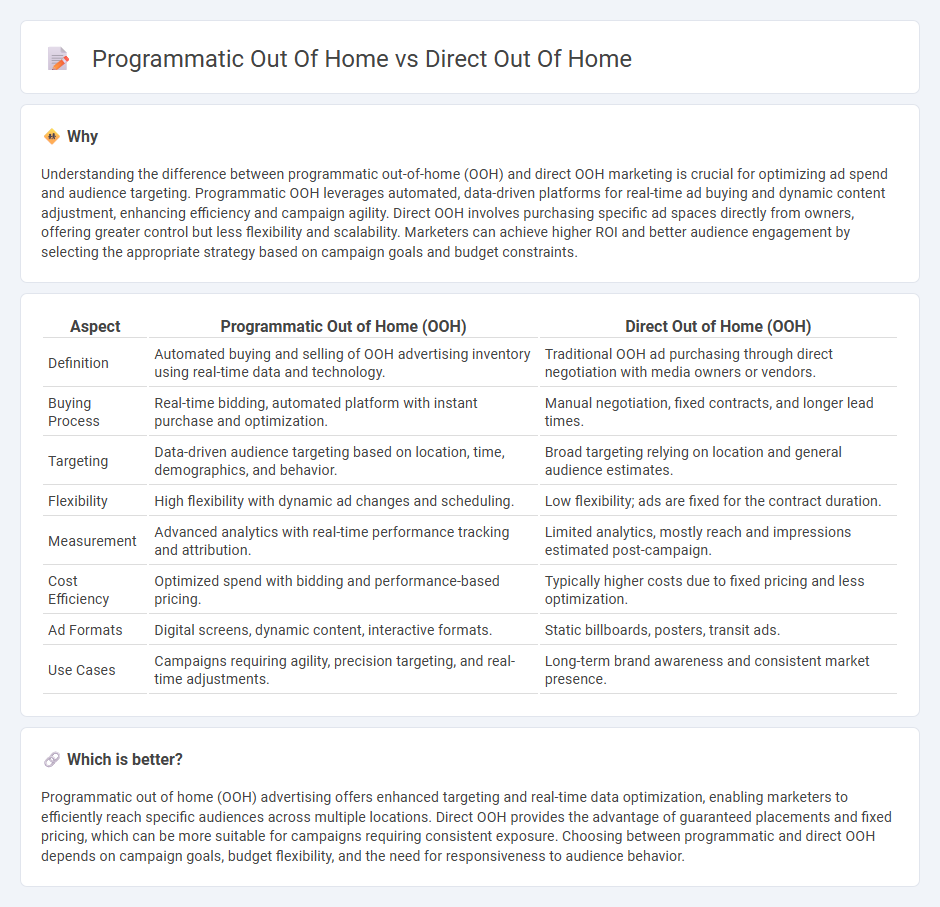
Programmatic out-of-home (OOH) advertising leverages automated technology and real-time data to target audiences with dynamic, personalized content across digital billboards and screens. Direct OOH involves manually purchasing fixed advertising space with static messages, often resulting in less flexibility and slower response times. Explore how each approach can enhance your brand's visibility and campaign efficiency in the evolving advertising landscape.
Why it is important
Understanding the difference between programmatic out-of-home (OOH) and direct OOH marketing is crucial for optimizing ad spend and audience targeting. Programmatic OOH leverages automated, data-driven platforms for real-time ad buying and dynamic content adjustment, enhancing efficiency and campaign agility. Direct OOH involves purchasing specific ad spaces directly from owners, offering greater control but less flexibility and scalability. Marketers can achieve higher ROI and better audience engagement by selecting the appropriate strategy based on campaign goals and budget constraints.
Comparison Table
| Aspect | Programmatic Out of Home (OOH) | Direct Out of Home (OOH) |
|---|---|---|
| Definition | Automated buying and selling of OOH advertising inventory using real-time data and technology. | Traditional OOH ad purchasing through direct negotiation with media owners or vendors. |
| Buying Process | Real-time bidding, automated platform with instant purchase and optimization. | Manual negotiation, fixed contracts, and longer lead times. |
| Targeting | Data-driven audience targeting based on location, time, demographics, and behavior. | Broad targeting relying on location and general audience estimates. |
| Flexibility | High flexibility with dynamic ad changes and scheduling. | Low flexibility; ads are fixed for the contract duration. |
| Measurement | Advanced analytics with real-time performance tracking and attribution. | Limited analytics, mostly reach and impressions estimated post-campaign. |
| Cost Efficiency | Optimized spend with bidding and performance-based pricing. | Typically higher costs due to fixed pricing and less optimization. |
| Ad Formats | Digital screens, dynamic content, interactive formats. | Static billboards, posters, transit ads. |
| Use Cases | Campaigns requiring agility, precision targeting, and real-time adjustments. | Long-term brand awareness and consistent market presence. |
Which is better?
Programmatic out of home (OOH) advertising offers enhanced targeting and real-time data optimization, enabling marketers to efficiently reach specific audiences across multiple locations. Direct OOH provides the advantage of guaranteed placements and fixed pricing, which can be more suitable for campaigns requiring consistent exposure. Choosing between programmatic and direct OOH depends on campaign goals, budget flexibility, and the need for responsiveness to audience behavior.
Connection
Programmatic Out of Home (OOH) and Direct Out of Home advertising are interconnected through their shared utilization of outdoor media platforms for targeted audience engagement. Programmatic OOH leverages automated technology and data analytics to optimize ad placements in real time, enhancing efficiency and audience precision. Direct OOH, relying on traditional buying methods, complements programmatic strategies by securing premium locations and ensuring brand consistency across high-impact physical sites.
Key Terms
Inventory Access
Direct out of home advertising provides guaranteed inventory access through pre-negotiated placements, ensuring premium locations and fixed ad durations. Programmatic out of home leverages automated bidding systems that offer flexible access to a broader range of inventory in real-time, optimizing reach and cost-efficiency. Explore how these inventory access methods can impact your campaign strategy and effectiveness.
Real-Time Bidding
Direct Out of Home (DOOH) advertising allows advertisers to buy specific ad placements directly, ensuring premium locations and guaranteed impressions, while Programmatic Out of Home (POOH) leverages Real-Time Bidding (RTB) to purchase impressions dynamically based on audience data and campaign goals. RTB in POOH enhances targeting precision and budget efficiency by enabling automated, real-time transactions across multiple digital screens. Discover how RTB transforms OOH ad strategies for maximizing reach and impact.
Campaign Flexibility
Direct out of home (OOH) advertising offers fixed placements with predetermined durations and creative content, limiting real-time adjustments. Programmatic OOH utilizes automated buying systems that enable dynamic ad changes based on data inputs such as time, weather, and audience demographics, enhancing campaign flexibility significantly. Explore how programmatic OOH can optimize your advertising strategy for maximum impact.
Source and External Links
What is digital out-of-home (DOOH) media? Definition ... - Digital out-of-home (DOOH) advertising is a data-driven, dynamic form of outdoor advertising found in public spaces on digital billboards and signage, allowing real-time, contextually relevant content delivery to targeted audiences at scale.
What Is DOOH Advertising and How Does It Work? - DOOH enhances traditional out-of-home advertising by using AdTech for geofencing, retargeting, and real-time dynamic ad display, making it programmable and measurable for advertisers.
Digital out-of-home (DOOH) advertising - DOOH combines the impact of traditional outdoor media with the flexibility of digital platforms, enabling programmatic targeting and delivering more targeted, measurable advertising results.
 dowidth.com
dowidth.com